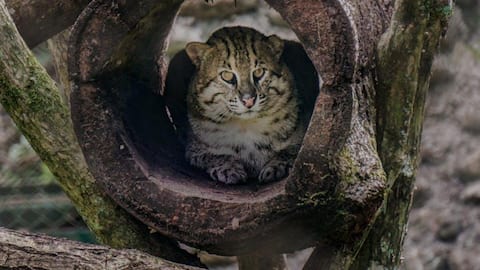Our Terms & Conditions | Our Privacy Policy
Essential facts about India’s aquatic hunter: The fishing cat
Was a long read? Making it simpler…
What’s the story
The fishing cat is a unique and elusive wild feline found in the wetlands of South and Southeast Asia, including India.
Primarily nocturnal, these cats are seldom seen, though they are common in the Sundarbans of West Bengal.
Well adapted to their aquatic habitat, fishing cats play a vital role in the ecosystem.
Here are intriguing facts about this remarkable species.
Aquatic adaptation
Fishing cats are uniquely adapted to life in wetlands, making them exceptional hunters in aquatic environments.
As piscivores, they primarily target fish as their main prey in these habitats.
Their partially webbed paws enhance their swimming ability, allowing them to pursue prey effectively in the water.
This adaptation enables them to hunt a variety of aquatic animals, constituting a significant portion of their diet
Unique hunting techniques
To catch fish, fishing cats employ unique hunting techniques.
They often wade into shallow water and use their sensitive paws to detect vibrations.
Once they locate their prey, they can swiftly swipe at it with their claws.
Fishing cats may also use a method called “fishing,” where they submerge their forelimbs to grasp fish or other aquatic animals, showcasing their remarkable skill set.
Solitary behavior
Like many wild cats, fishing cats are solitary creatures.
They establish territories that they mark with scent to communicate with other fishing cats.
Males typically have larger territories than females, and they may overlap with each other’s ranges.
Their solitary nature makes them elusive and challenging to study, contributing to the limited knowledge about their behavior and ecology.
Conservation status
Fishing cats are classified as “Vulnerable” on the IUCN Red List due to habitat loss, poaching, and declining prey availability.
The “fishing cat tourism” initiative, promoted through Sundarban wildlife tours, seeks to involve local communities in West Bengal’s wetland habitats.
Its main goal is to preserve the fishing cat population and their environment, emphasizing habitat restoration, community awareness, and anti-poaching measures.
Images are for reference only.Images and contents gathered automatic from google or 3rd party sources.All rights on the images and contents are with their legal original owners.



Comments are closed.